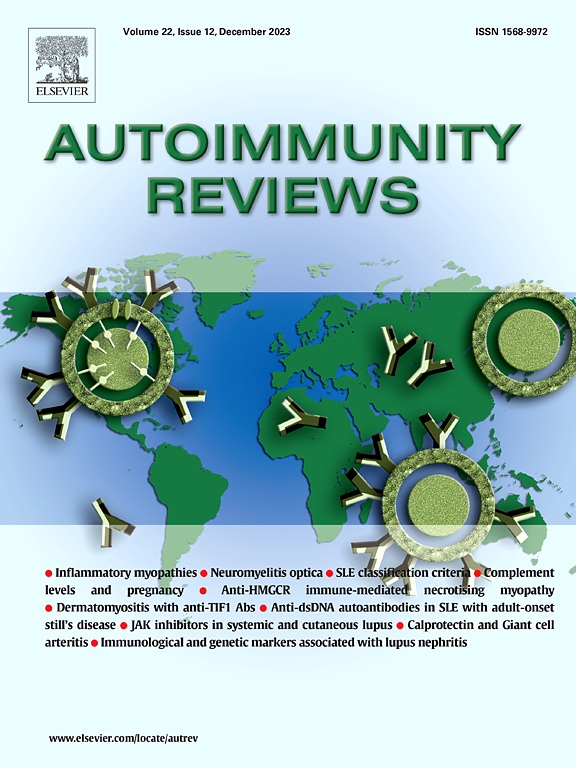The role of double-negative B cells in the pathogenesis of systemic lupus erythematosus
IF 8.3
1区 医学
Q1 IMMUNOLOGY
引用次数: 0
Abstract
B cells are essential to the pathophysiology of systemic lupus erythematosus (SLE), a chronic autoimmune illness. IgD-CD27-double negative B cells (DNB cells) are one of the aberrant B cell subsets linked to SLE that have attracted much scientific interest. There is growing evidence that DNB cells play a significant role in the development of the disease and are strongly linked to the activity of lupus. These cells play a pivotal role in the pathogenesis of SLE by producing a diverse array of autoantibodies, which form immune complexes that drive target organ damage. A comprehensive understanding of SLE pathophysiology necessitates in-depth investigation into DNB cells, not only to elucidate their mechanistic contributions but also to uncover novel therapeutic strategies.
According to available data, treatments that target B cells have proven effective in managing SLE; nevertheless, a significant breakthrough in precision medicine for SLE may come from targeting DNB cells specifically. Despite growing interest in DNB cells, their precise characteristics, developmental trajectories, and regulatory mechanisms remain incompletely defined, posing significant challenges to the field. A comprehensive investigation of the regulatory mechanisms governing DNB cell differentiation and expansion in SLE may facilitate novel therapeutic discoveries. This review aims to provide an updated synthesis of current research on DNB cells, with a focus on their origins, developmental trajectories in SLE, and potential as precision therapeutic targets.
双阴性B细胞在系统性红斑狼疮发病机制中的作用
B细胞对系统性红斑狼疮(SLE)的病理生理至关重要,SLE是一种慢性自身免疫性疾病。igd - cd27双阴性B细胞(DNB细胞)是与SLE相关的异常B细胞亚群之一,引起了许多科学兴趣。越来越多的证据表明,DNB细胞在疾病的发展中起着重要作用,并与狼疮的活动密切相关。这些细胞通过产生多种自身抗体,形成驱动靶器官损伤的免疫复合物,在SLE的发病机制中发挥关键作用。全面了解SLE病理生理需要深入研究DNB细胞,不仅要阐明其机制作用,而且要发现新的治疗策略。根据现有数据,针对B细胞的治疗已被证明对SLE有效;然而,SLE精准医学的重大突破可能来自于特异性靶向DNB细胞。尽管人们对DNB细胞的兴趣日益浓厚,但它们的确切特征、发育轨迹和调控机制仍未完全确定,这给该领域带来了重大挑战。对SLE中DNB细胞分化和扩增的调控机制的全面研究可能会促进新的治疗发现。本文综述了DNB细胞的最新研究成果,重点介绍了DNB细胞在SLE中的起源、发育轨迹以及作为精准治疗靶点的潜力。
本文章由计算机程序翻译,如有差异,请以英文原文为准。
求助全文
约1分钟内获得全文
求助全文
来源期刊

Autoimmunity reviews
医学-免疫学
CiteScore
24.70
自引率
4.40%
发文量
164
审稿时长
21 days
期刊介绍:
Autoimmunity Reviews is a publication that features up-to-date, structured reviews on various topics in the field of autoimmunity. These reviews are written by renowned experts and include demonstrative illustrations and tables. Each article will have a clear "take-home" message for readers.
The selection of articles is primarily done by the Editors-in-Chief, based on recommendations from the international Editorial Board. The topics covered in the articles span all areas of autoimmunology, aiming to bridge the gap between basic and clinical sciences.
In terms of content, the contributions in basic sciences delve into the pathophysiology and mechanisms of autoimmune disorders, as well as genomics and proteomics. On the other hand, clinical contributions focus on diseases related to autoimmunity, novel therapies, and clinical associations.
Autoimmunity Reviews is internationally recognized, and its articles are indexed and abstracted in prestigious databases such as PubMed/Medline, Science Citation Index Expanded, Biosciences Information Services, and Chemical Abstracts.
 求助内容:
求助内容: 应助结果提醒方式:
应助结果提醒方式:


